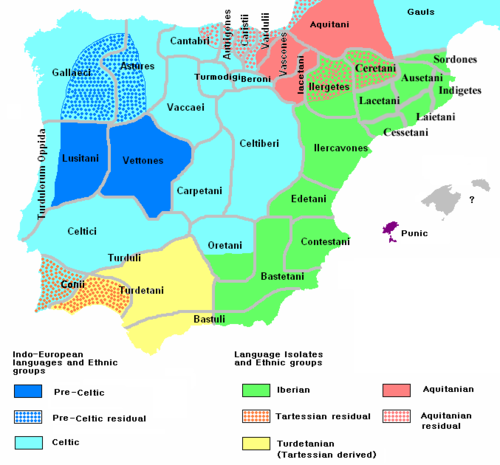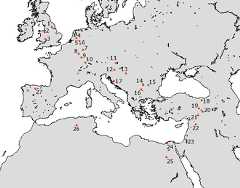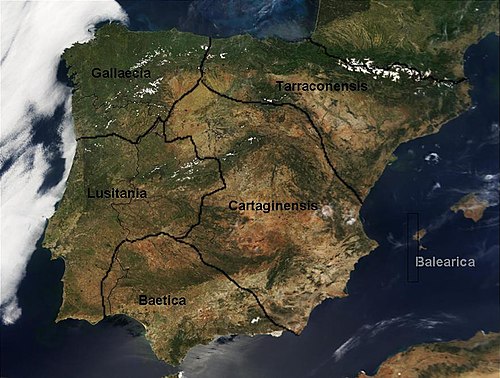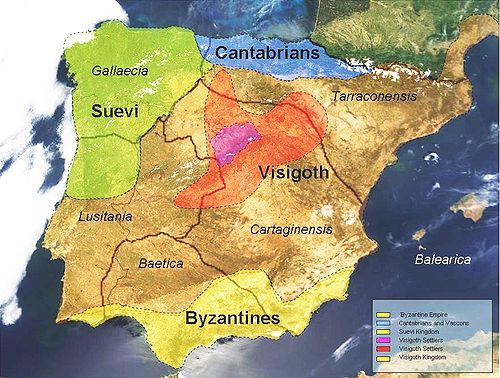 | Wikimedia Commons Atlas of the World TheWikimedia Atlas of the World is an organized and commented collection of geographical, political and historical maps available atWikimedia Commons. Discussion •Update the atlas •Index of the Atlas •Atlas in categories •Other atlases on line |  |
|
| ||||||||||||||||||||||||||||||||||||||||
 | Galicia |
 | Map of Galicia |
 | Linguistic map |
 | Detailled linguistic map of Galicia |
 | Percentage of Galician speakers |
 | Population density in Galicia |
This section holds a short summary of the history of the area of present-day Galicia, illustrated with maps, including historical maps of former countries and empires that included present-day Galicia.====Early history====Languages of SpainLanguages of Spain.svg.svg
 | Palaeolithic art |
 | Neolithicum in Europe 5th millennium BCE |
 | Europe in ca.4500 BC-4000 BC |
 | Europe in ca.4000 BC-3500 BC |
 | Beaker culture |
 | Extent of theBeaker culture (ca. 2800 – 1900 B.C.) |
 | Pre-historic art in Iberia |
 | The Iberian Peninsula (Spain and Portugal) in the bronze age |

 | Ethnographic Iberia 200 BCE |
 | Prehispanic languages and tribes |
 | Prehispanic languages |
 | Paleohispanic writing systems excluding proper Lusitanian |
 | Possible extent of (proto-)Celtic influence 800-400 BC |
 | Celts in Europe |
| Celts in Iberia (200 BC) |
 | Celts: Hallstatt (yellow) and La Tène (green) cultures |
 | Territorial development of theRoman Empire 264 BC-192, including the conquest of present Spain |
 | TheRoman Republic andCarthago in 218, just prior to theSecond Punic War |
 | Hannibals invasion in thePunic Wars |
 | Roman Republic 100 BCE |
 | Map of theRoman Empire in 50 |
 | The extent of theRoman Republic andRoman Empire; |
 | Camps of the Roman Legions in 80 |
 | Map of theRoman Empire in 116 |
 | Roman Empire in 117 |
 | Hispania under Octavio César Augusto (29-19 a. J. C.), after the Cantabrians Wars |
 | Hispania under Dioclecian, 293 AC |
 | Roman provinces in Iberia |
 |
 |
 | Roman Empire divided 395 |
 | The division of the Empire after the death ofTheodosius I, ca.395 AD superimposed on modern borders. |
 | Western Roman Empire 395 |
 | Invasions of theRoman Empire 100-500 |
 | Invasions of the Roman Empire 100-500 |
 | Division of the Roman Empire in 406 |
 | Iberian Peninsula Around 560 AC |
 | Visigoths migrations |
 | Kingdom of theVisigoths |
 | Spain in 564 |
 | Visigoths andSueves |
 | Kingdom of Suvean Galicia |
 | Conquest by theCaliphs |
 | Caliphate around 750 |
 | Europe in 814 |
 | Empire of theAlmoravides (in Spanish) |
 | Empire of theAlmoravides (in English) |
 | Emirate of Cordoba |
 | Emirate of Cordoba |
 | Taifas in 1080 |
 | The Reconquista |
 | The Reconquista |
 | The Reconquista |
 | Habsburg Empire in 1547 |
 | Routes of the Armada against Britain and the Netherlands |
 | Europe underNapoleon |
 | Civil War in 1936 |
 | Civil War in 1937 |
 | Civil War in 1938 |
| Civil War in 1939, White: Spanish Republic Grey: Fascist |
This section holds copies of original general maps more than 70 years old.
 | Mapa del Reyno de Galicia, 1784 |
 | Spain in 1905, Bibliothek allgemeinen und praktischen Wissens für Militäranwärter Band I, 1905 |
 | Languages of Spain: Galician, official Astur-Leonese, unofficial Spanish, official Aragonese, unofficial Catalan, official Occitan, official Basque, official |
 | Languages of Spain and dialects of Castillian |
 | ecclesiastic division map o Galicia |
 | Density of population |
 | Foreign population |
 | Main agglomerations in Spain |
 | The AVE Hight speed Railway Network |
General remarks:
|